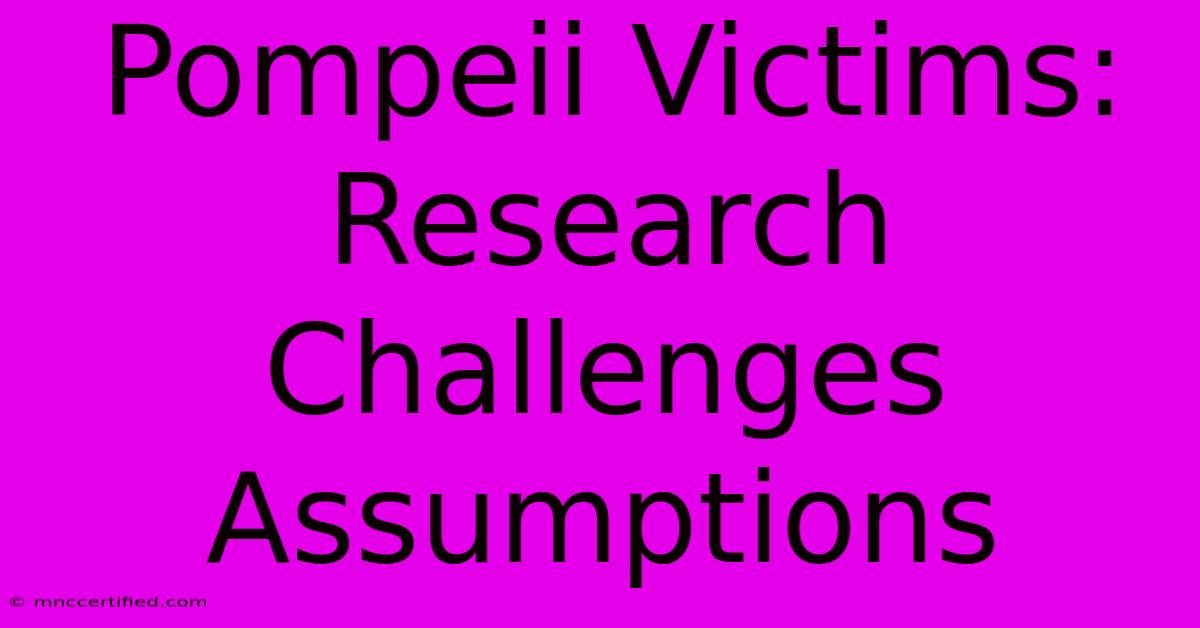Pompeii Victims: Research Challenges Assumptions

Table of Contents
Pompeii Victims: Research Challenges Assumptions About the Eruption
The eruption of Mount Vesuvius in 79 AD, which buried the Roman city of Pompeii, has captivated the world for centuries. The tragic fate of its inhabitants, frozen in time by the volcanic ash, has provided a unique window into the lives of ancient Romans. However, recent research is challenging long-held assumptions about the victims and the eruption itself.
Beyond the Plaster Casts: Unveiling the Truth
For decades, the plaster casts of Pompeii victims have been the most iconic representation of the disaster. These haunting figures, preserved in the hardened ash, provide a glimpse into the final moments of their lives. However, these casts only tell part of the story. Recent archaeological investigations have revealed a more complex picture of the eruption and its impact.
Challenging the "Instant Death" Theory:
The popular narrative surrounding Pompeii often depicts the eruption as a swift, catastrophic event leading to immediate death for all. However, research suggests a more nuanced reality.
- Multiple Phases: The eruption involved several phases, with the initial ash fall being relatively slow. This suggests that many inhabitants had time to flee or seek shelter.
- Slow Suffocation: While some died quickly from heat or asphyxiation, others perished more slowly from the effects of volcanic gases and ash.
- Survival Stories: Evidence suggests that some individuals survived the initial phases of the eruption and remained in the city for extended periods.
Beyond the Plaster Casts: A More Complex Picture
While the plaster casts are captivating, it's important to remember they represent only a small fraction of the victims. Recent excavations have unearthed skeletons in various positions, suggesting different causes of death and survival strategies.
- Varied Causes of Death: Analysis of skeletal remains reveals a variety of causes of death, including suffocation, burns, and trauma. This indicates that the eruption's impact was not uniform, with different individuals experiencing different fates.
- Individualized Responses: Excavations have revealed evidence of looting, indicating that some individuals attempted to salvage belongings even after the eruption. This suggests that the response to the disaster was not a collective panic, but rather a series of individual responses.
The Eruption: More Than Just Ash
The eruption itself is also being re-evaluated.
Pyroclastic Flows: The Real Threat
While the ash fall is often depicted as the primary cause of death, the real threat came from pyroclastic flows. These superheated currents of gas and volcanic debris were responsible for the most devastating destruction and caused widespread casualties.
The Role of the Wind:
The direction and intensity of the wind played a crucial role in the spread of the pyroclastic flows and their impact on Pompeii. Recent studies are exploring the influence of wind patterns on the eruption's course, challenging previous interpretations.
The Legacy of Pompeii: A Constant Evolution
The study of Pompeii is an ongoing process, with new discoveries constantly challenging existing assumptions.
New Technologies: The use of advanced technologies such as ground-penetrating radar and 3D scanning is providing new insights into the city's structure and the events of the eruption.
International Collaboration: The collaboration of researchers from various disciplines is contributing to a more holistic understanding of Pompeii's history and the eruption that engulfed it.
The Importance of Continuous Exploration: As new evidence emerges, our understanding of the Pompeii eruption and its victims continues to evolve.
Conclusion:
The Pompeii victims' stories are not simply a tale of instant tragedy. The research reveals a more nuanced picture of survival, adaptation, and individual responses to the devastating event. This ongoing exploration helps us better understand the complexities of ancient life and the resilience of humans in the face of disaster. The victims of Pompeii continue to teach us valuable lessons about the past and how to prepare for the future.

Thank you for visiting our website wich cover about Pompeii Victims: Research Challenges Assumptions. We hope the information provided has been useful to you. Feel free to contact us if you have any questions or need further assistance. See you next time and dont miss to bookmark.
Featured Posts
-
Mike Tyson Discusses Dumas And Leonard
Nov 09, 2024
-
Abc Advantage Health Insurance Reviews
Nov 09, 2024
-
Danny Aarons And Tennessee Thresher Their Relationship Status
Nov 09, 2024
-
Ionic Covalent Bonds Worksheet Answers
Nov 09, 2024
-
Ls Robinson Insurance Southwest Harbor
Nov 09, 2024